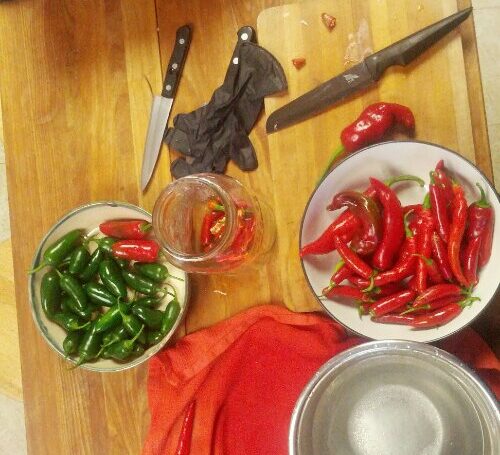
Garden Tuesday : Countertop Hot Sauce.
I like hot sauce. I put it on everything, but, by and far, I love hot sauce with eggs.
Now, Tabasco is nice if you are aiming for a strong vinegar influence. Nothing against Tabasco, I personally have a fine collection of it in my refrigerator. The Chipotle stuff, the Green stuff and the Original stuff, but let’s face it, Tabasco is a vinegar product more than a pepper product. Yes, read it for yourself if you don’t believe me. The first ingredient on the list is indeed vinegar. And, it is not a nice vinegar, it is distilled, white vinegar.
Distilled, white vinegar is the stuff that can be used as a household cleaner and surface disinfectant. That’s right, Lysol and distilled white vinegar can be used for the same task, but I can actually digest vinegar. Personally, I have found white vinegar can also go head-to-head with some of the strongest cleaners in the kitchen. It is excellent at cutting grease and if you infuse it with some good stuff like citrus peels and vanilla, it actually doesn’t leave the kitchen smelling like vinegar, but that is a recipe for another post. This is about hot pepper sauce and alternatives to Tabasco for my morning eggs.
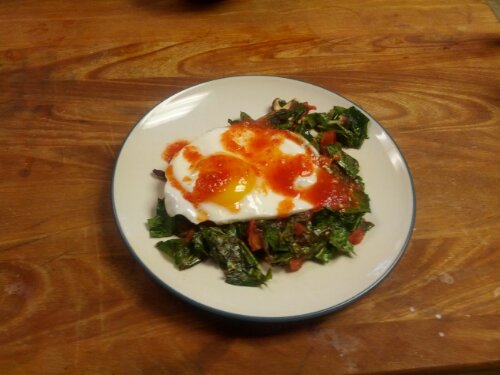
I know some of you are preparing angry comments to me for defaming Tabasco, but, seriously, let’s face the facts. Tabasco is more pepper flavored vinegar than pepper sauce with vinegar. I love the stuff.
But, sometimes, I want something less, well, less vinegary and more peppery.
I have tried lots of other pepper sauces. There is the Srichacha sauces that come in the ubiquitous clear bottles with the green caps cap and the white stenciled chicken. That last feature gets it fondly referred to as chicken or cock sauce around these parts. The version in the squeeze bottle is the smooth and bended, creamy version. This is a potently garlic sauce that can easily be applied in quarter bottle servings. My preference, however, is the chunkier, sweeter and perhaps hotter spoonable version in the twist top jars.
I love these chicken sauces too. While they are certainly less vinegary, they are insanely rich, dense and garlicky. This makes it okay on a cheddar omlette, but I find it overpowers the simple fried or poached egg.
So, I could go on and on like this reviewing sauce after sauce. There are tons of hot sauces on the market. It seems like everyone is making mom’s, dad’s, grandpa’s, grandma’s or some other relative’s secret sauce in a bottle. Then, there are these crazy sauces with labels that warn of certain death with an overdose. While I am an adventurous eater, I adventure for pleasure and not pain.
But this is not Sauce Tuesday, this is Garden Tuesday. So, naturally, I am going to talk about making some sauce. And, naturally, that sauce is going to be perfect for a fried egg, a poached egg, a scrambled egg, an omelett and, frankly, it is going to be awesome right out the jar. It will not be too vinegary, because it has no vinegar. It will not be too rich, because it is just vegetables. It will not be too garlicky, because you can put as much or as little in as you like. It will not be too hot, because, well, because it just won’t, that’s why.
Now, you might wonder how I will get to this wonderful and mysterious utopian sauce place? Through the magic of lacto-fermentation, that’s how.
You may know the term ‘fermentation’ from the many wonderful libations produced through this magical process. If you don’t, well, let’s just say a little one-celled micro-organism called yeast is responsible for bringing us the wonderful concoctions of beer and wine. Yeasts are heros in my book. Millions and millions of little yeasts digest sugars in grain mashes and juice and poop (respire, if you like) alcohol and carbon dioxide. All hail the yeast!
Beer and wine may be the most well-known fermentation products, but there are micro-organisms everywhere that can ferment and transform all kinds of foods. If you provide the right environment, many micro-organism will create this transformation naturally through wild fermentation. While beer and wine can be wild fermented, they are typically produced using specific strains yeast with a precise, sanitary scientific process that actually aims to hinder wild fermentation. For you sour fans, I know this isn’t universally try, but let’s keep it simple.
Personally, I am aiming for something far less exacting for my hot pepper sauce. Fortunately, vegetables have lots of lactobacilli on their surface and all these lactobacilli need to thrive is a saline environment. Traditional sauerkrauts are produced through this process. No, not that sauerkraut-like stuff found in the grocery store or at the hot dog stand. Like Tabasco, that stuff is largely vinegar. The cabbage is merely a carrier for the vinegar. Real, traditional sauerkraut is made through lacto-fermentation. It requires nothing more than cabbage, salt and time to turn a rather boring head of cabbage into a crunchy, tangy, slightly sour and slightly sweet concoction. Not to mention, unlike that vinegar process, lacto-fermentation results in a Sauerkraut teaming with good gut bacterias. It is this simple sauerkraut principle that I like to my hot pepper sauce.
This year, I was fortunate enough to have a pretty large crop or cayenne peppers, jalapeños and serranos available from my garden and my CSA share. When they were piling up on the counter in great abundance, I started my hot pepper ferment. Seriously, this is all as simple as cleaning the peppers, packing them in a jar, submerging them in a saline solution and leaving them on the counter for several weeks.
No, don’t refrigerate them. Lactobacilli need to be warm to do their magic. Yes, this is safe. The saline solution prevents the peppers from decaying and provides an environment where the Lactobacilli can thrive. In fact, they outcompete other bacteria while many other harmful bacterias cannot survive in this environment.
As they sit on the counter, those little bacteria have a a party. Over the course of the fermentation, different types Lactobacilli will dominate the environment based on changes in the pH. So, the peppers will take on a different flavor at different times. This means the flavors will change over time, so it is good to taste the ferment periodically to dial in a particularly pleasing level of sourness. Once you reach a level of deliciousness, all that is left is to dump the whole jar into a blender and puree it until it is smooth. I adjusted mine with some sweet peppers, tomatoes and garlic.
Now, this is the perfect egg compliment – sweet, hot, tangy, salty with a light garlic and zero vinegar.
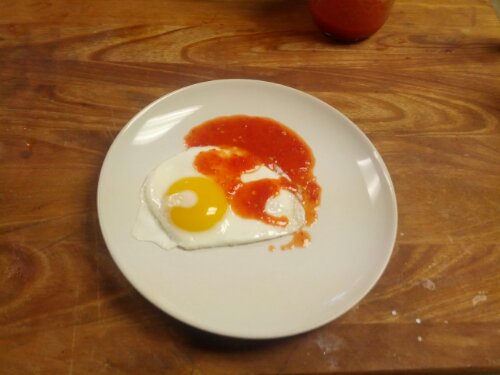
Fermented Blender Hot Sauce
Peppers of a variety of your choice, enough to fill your selected vessel
Garlic to your taste
Fine Sea Salt (use at a rate of 1-1/2 Tablespoons per quart of water)
Water (It is best to let the water stand overnight to allow any chlorine to evaporate off)
This is a very forgiving recipe. I don’t use a lot of strict measurements except in the salt to water ratio. This ratio is necessary for the proper environment. You can also use any kind of salt excepted iodized salt. Iodized salt may kill the beneficial bacterial. If a courser salt is use, adjust the amount to achieve a similar salinity.
You can add other seasonings such as pepper, juniper berries, herbs or otherwise depending on your desired taste. I used cayenne and sweet Italian peppers for a sharply hot, sweet and bright red sauce. A few Jalapeños were also mixed in to give a more earthy flavor with soft, lingering heat. The additional serranos bring a bit of the sharp heat and light earthiness. For a powerfully hot sauce, you can also do this with scotch bonnets/habenaros, but I personally don’t care for the pain.
1. Gather all your ingredients and dissolve the salt in the water. No need to boil, just add the salt to the water and allow enough time for it to fully dissolve. Mix enough to fill the fermenting container remembering it is better to have some excess than not enough.
2. Roughly chop up the peppers and crush the garlic cloves. I wanted to moderate my heat, so I also de-seeded several peppers. I also like to cut open the peppers to watch out for bad spots and ensure there is no trapped air, but the peppers can be put in with only a rough chop including the stems and all. Remember to wear gloves when handling peppers or you will be reminded of them later.
3. Pack the peppers, garlic and any herbs into a jar. Pour some of the saline liquind in as you go to ensure there is no trapped air pockets. Weigh down the peppers to ensure they remain submerged. This is the first time using it, but I am trying out the weights from Fermentocap.

4. Cap the jar and sit on the counter top for 1-6 weeks. Replenish the salt water as need if it evaporates over time. It is important to keep the peppers fully submerged. Peppers exposed to air may rot. I used the Fermentocap and did not have to top off water over a 4-week ferment.
5. Once the peppers reach your desired flavor, check the surface of the ferment and skim off any skum that has formed. This is harmless, but it forms where at the air interface. Pour the entire contents of the jar into the blender and puree to the desired consistancy. Transfer to smaller jars and keep in the refrigerator.
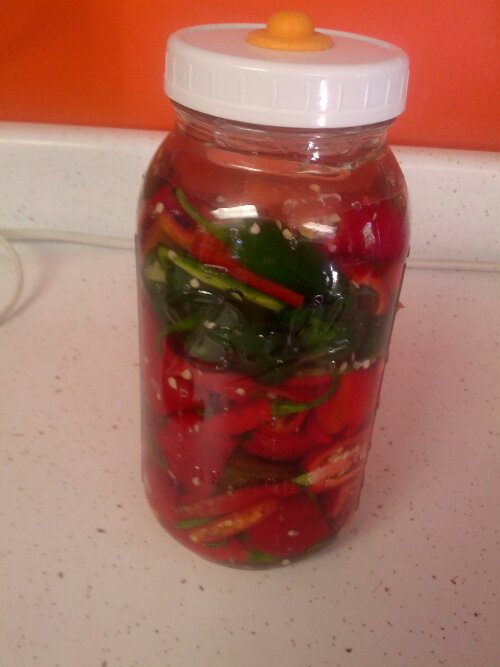
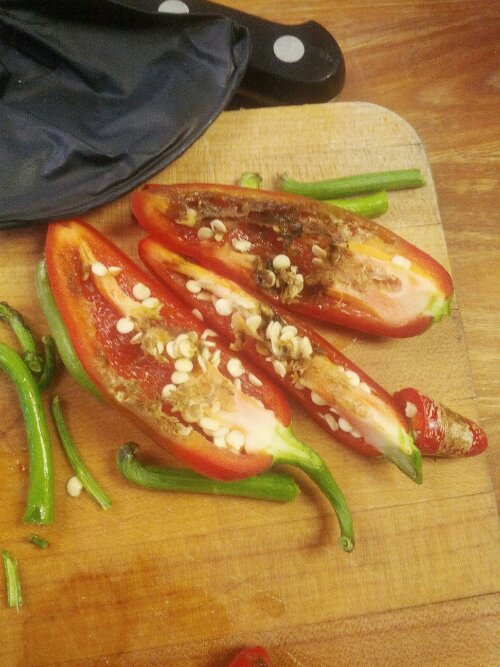
Leave a Reply